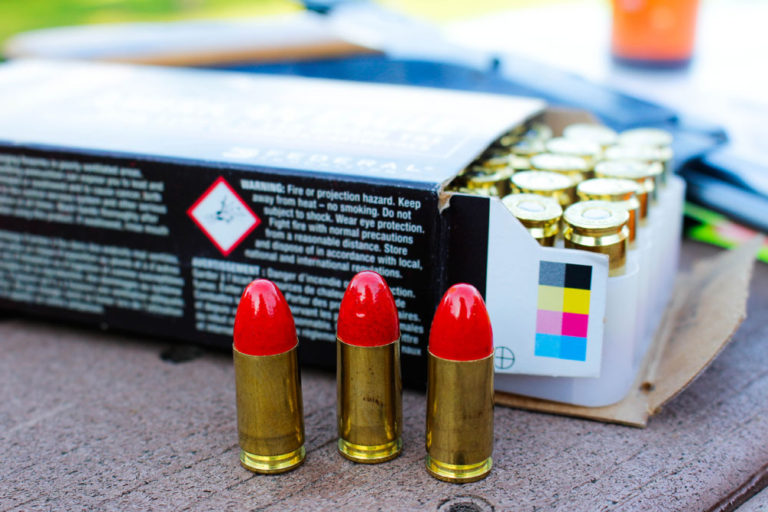
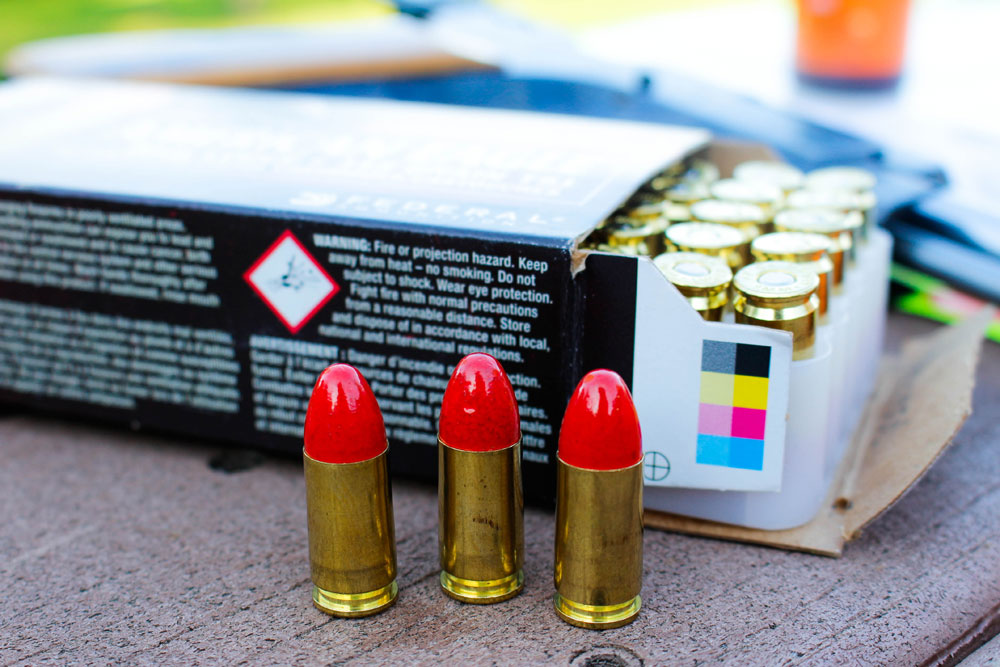 I am by no means a fan of cleaning firearms. I absolutely love the smell of Hoppe’s No. 9 (I’ve been known to use it as cologne) but cleaning guns is a chore and I avoid it like the plague, especially semi-automatic pistols. You know the routine: Take ‘em apart, clean ‘em, reassemble, rinse and repeat. It’s much more fun to shoot.
I am by no means a fan of cleaning firearms. I absolutely love the smell of Hoppe’s No. 9 (I’ve been known to use it as cologne) but cleaning guns is a chore and I avoid it like the plague, especially semi-automatic pistols. You know the routine: Take ‘em apart, clean ‘em, reassemble, rinse and repeat. It’s much more fun to shoot.
While at the SHOT Show’s Industry Day at the Range, the fine gents from Federal Premium told me about the company’s new American Eagle Syntech ammunition, and I was immediately intrigued.
“Phil it burns cleaner, keeps the barrel cooler due to our synthetic jacket on the bullet severely reducing friction, and will actually reduce muzzle jump. It even features a lead-free primer, perfect for use in an indoor range,” said J.J. Reich, the Public Relations Manager for Federal.
Burns cleaner? That translates to less cleaning, right? I had to try this stuff, and see if it lived up to those claims. I figured a decent test would be to compare the Syntech stuff to the American Eagle FMJ ammo, a common choice for range work, and see if there was any observable difference. So, I grabbed up a few boxes of each type of ammo, in 9mm Luger—147-grain FMJ stuff, and the 115-grain Syntech load—as well as the Hoppe’s cleaning kit and my trusty Lyman cleaning rod and headed to the range.
 I started out by thoroughly cleaning the test gun, a Tangfolio 9mm, and proceeded to fire 50 rounds of the FMJ load, checking the barrel heat in 10-shot intervals, and then cleaned the pistol again. I then repeated the process using the Syntech ammo, noting any differences between the two types of ammunition. The results were rather interesting, if not exactly scientific; but they do relate to real-world scenarios. Comparing the solvent-soaked patches, it was very clear that the Syntech ammo left much less of a mess. Not that the FMJ ammo was exactly a filthy affair, but there was much less fouling and residue left behind from the Syntech ammunition.
I started out by thoroughly cleaning the test gun, a Tangfolio 9mm, and proceeded to fire 50 rounds of the FMJ load, checking the barrel heat in 10-shot intervals, and then cleaned the pistol again. I then repeated the process using the Syntech ammo, noting any differences between the two types of ammunition. The results were rather interesting, if not exactly scientific; but they do relate to real-world scenarios. Comparing the solvent-soaked patches, it was very clear that the Syntech ammo left much less of a mess. Not that the FMJ ammo was exactly a filthy affair, but there was much less fouling and residue left behind from the Syntech ammunition.
And as far as the cooler burning claim, I must report that there was a definite, appreciable difference in barrel heat, and the Syntech stuff did in fact run cooler than the FMJ ammo. After about 30 rounds of FMJ ammunition, the barrel was absolutely too hot to touch—not really good for the pistol, but hey, this is science after all—but not so with the Syntech ammo. Using a 10-round magazine, and only allowing enough time to reload between firings, the Syntech ammo still allowed the barrel to be touched after 50 rounds. The Syntech ammunition produced less muzzle jump than did the FMJ variant, though a part of that equation may have been the difference in bullet weight—147 grains for the FMJ and 115 grains for the Syntech—but all in all I was able to get back on target faster with the lighter load. So far, I had quickly become a fan of the new design, and could easily see the benefits of the engineering efforts. I had no means of testing the chemical composition of the new Catalyst lead-free primer, other than to report the fact that it gave reliable ignition, so I’ll have to take Federal’s word for it, but I can easily see where a lead-free primer would be welcomed in any of the indoor shooting ranges that have become so popular. The less lead vapor in the air, whether from a projectile or the primer, the better.
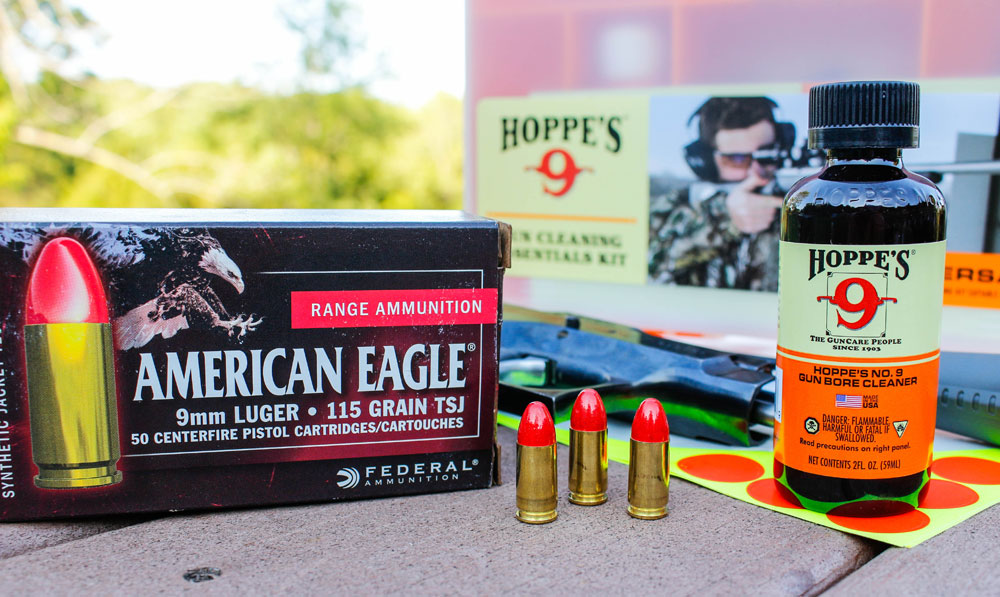 Now that I had a better feel for the ammo, and that those claims that J.J. Reich had made were actually validated, it was time to assess the accuracy and function of the ammunition.
Now that I had a better feel for the ammo, and that those claims that J.J. Reich had made were actually validated, it was time to assess the accuracy and function of the ammunition.
Firstly, this Tangfolio pistol has a rather stiff set of springs and has been known to stovepipe lesser, more feeble types of ammo, so I was concerned about the light-for-caliber 115-grain stuff. I wasn’t too awfully concerned about the 147-grain flat point FMJ stuff, as this gun usually likes that weight of bullet. I also knew that in my hands, this gun usually hits high at the 10-yard mark, so as long as point of impact was consistent, I would be happy.
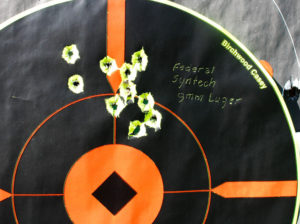 Both types of ammunition worked very well over the course of 100 rounds of each type with only two jams, one stovepipe with each type, and I’d attribute that to the rapid fire testing methods I had employed. There were no firing malfunctions, and the Syntech stuff proved to be rather accurate; I am a fair pistol shot, at best, and I could keep the groups to minute-of-softball, offhand, at ten paces. As expected, the groups were a bit on the high side, but that’s the way this gun handles when I’m behind the trigger. The Syntech ammo actually performed better than the 147-grain flat point FMJ stuff, in the accuracy department, to the point that I’d definitely prefer practicing with Syntech.
Both types of ammunition worked very well over the course of 100 rounds of each type with only two jams, one stovepipe with each type, and I’d attribute that to the rapid fire testing methods I had employed. There were no firing malfunctions, and the Syntech stuff proved to be rather accurate; I am a fair pistol shot, at best, and I could keep the groups to minute-of-softball, offhand, at ten paces. As expected, the groups were a bit on the high side, but that’s the way this gun handles when I’m behind the trigger. The Syntech ammo actually performed better than the 147-grain flat point FMJ stuff, in the accuracy department, to the point that I’d definitely prefer practicing with Syntech.
Running it through the Oehler 35P chronograph, the Syntech ammo ran at an average of 1,115 fps—just 15 fps below the advertised 1,130 fps—and gave rather uniform velocities, with the standard deviation on velocity being no more than 12 fps.
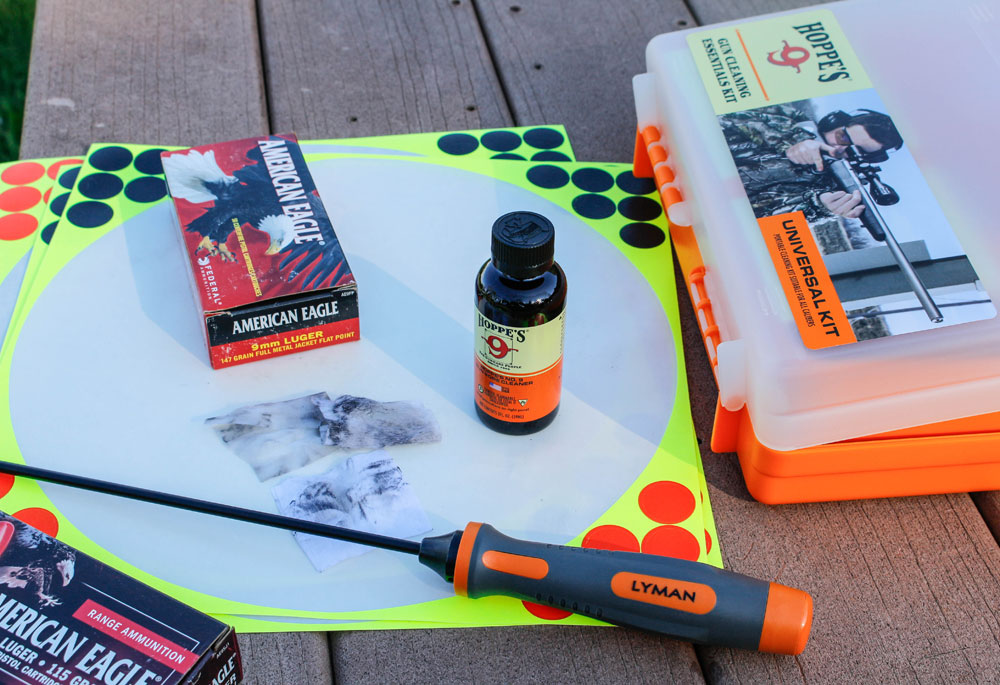 All in all, I feel the Syntech ammunition is worthwhile. The polymer coating, which completely encapsulates the lead projectile, definitely reduces the amount of lead being vaporized when firing your gun, as it doesn’t allow the burning gases or the rifling to touch the lead itself. The Total Synthetic Jacket, or TSJ as Federal calls it, is designed to stay intact during ignition as well as during flight. Federal also indicates that due to a lack of a copper jacket, the amount of lead splatter is reduced when shooting at steel plates, and while I had no means of measuring that, it does make logical sense.
All in all, I feel the Syntech ammunition is worthwhile. The polymer coating, which completely encapsulates the lead projectile, definitely reduces the amount of lead being vaporized when firing your gun, as it doesn’t allow the burning gases or the rifling to touch the lead itself. The Total Synthetic Jacket, or TSJ as Federal calls it, is designed to stay intact during ignition as well as during flight. Federal also indicates that due to a lack of a copper jacket, the amount of lead splatter is reduced when shooting at steel plates, and while I had no means of measuring that, it does make logical sense.
For the shooter who turns large amounts of ammunition into piles of spent brass over the course of a weekend, American Eagle’s Syntech is an excellent blend of affordability, reliability and results. The cooler temperature will allow your pistol to cycle smoother, and the fact that the gun will run cleaner is a huge benefit to all of us. As sweet as Hoppe’s No. 9 smells, the less I have to use it, the happier I am. Here’s to cleaning less!
Editor's Note: This article is an excerpt from the September 2016 issue of Gun Digest the Magazine.

Next Step: Get your FREE Printable Target Pack
Enhance your shooting precision with our 62 MOA Targets, perfect for rifles and handguns. Crafted in collaboration with Storm Tactical for accuracy and versatility.
Subscribe to the Gun Digest email newsletter and get your downloadable target pack sent straight to your inbox. Stay updated with the latest firearms info in the industry.

![Best Concealed Carry Guns In 2025 [Field Tested] Wilson Combat EDC X9S 1](https://gundigest.com/wp-content/uploads/Wilson-Combat-EDC-X9S-1-324x160.jpg)


![Best 9mm Carbine: Affordable PCCs [Tested] Ruger Carbine Shooting](https://gundigest.com/wp-content/uploads/Ruger-Carbine-Shooting-100x70.jpg)
![Best AR-15: Top Options Available Today [Field Tested] Harrington and Richardson PSA XM177E2 feature](https://gundigest.com/wp-content/uploads/Harrington-and-Richardson-PSA-XM177E2-feature-100x70.jpg)
